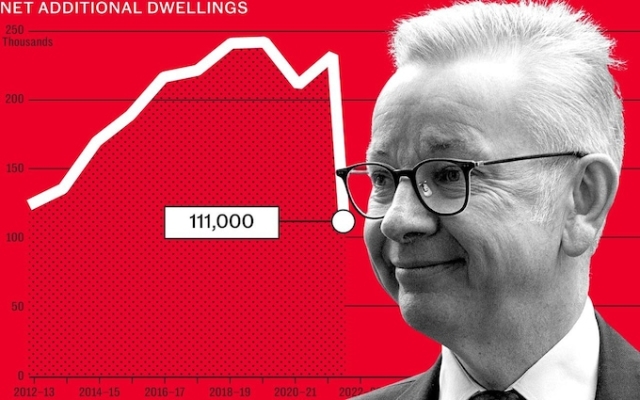
Humble trout farmer after Michael Gove unleashed a regulatory whirlwind on the UK housing industry.
< p>But the Secretary of Housing is presiding over a tangled mass of environmental regulations that have turned this unlikely business into a must-have asset.
Developers have realized they can get around so-called nutrient neutrality restrictions, which prevent them from adding nitrates to their water supply by buying up trout farms and then shutting them down.
This is just one example of the acrobatic planning that has become all too common for long-suffering construction companies trying to work their way through mountains of red tape.
As restrictions become more onerous, the industry fears the Government risks causing a collapse in construction, further exacerbating the housing crisis.
Housing Index 1605
“Government’s capitulation to Nimby’s lobby and its mishandling of water legislation and sewers could result in fewer homes being built than ever before,” says Stuart Baisley, executive chairman of the Federation of Home Builders, a trade organization.
The Policy is currently the most hostile to developers in at least 15 years, he said.
According to analysis by consultants Lichfields for HBF, under the current policy trajectory, in the worst case, net annual housing supply will fall from 230 000 to 111,000.
This will be an all-time low and the loss of 122,000 homes a year is a 53% drop.
«Nimby's lobby has definitely got the upper hand in government at the moment,» says Simon Koop, who leads the housing development group at Lichfields. of neutrality introduced by Natural England in 2019, which require compensation for any changes in nitrate levels in the local water supply due to development.
As a result, plans covering 120,000 homes in 74 local government areas are on hold.
One developer in the north of England has calculated that up to 3,500 acres of farmland would have to be cleared in accordance with regulations in order for their construction to be greenlit.shutting them down to reduce nitrate entry into the rivers so they can demonstrate neutrality,” Baisley says.
Acquisition of trout farms, which He adds that the natural proximity to waterways and therefore greatly affects the local nitrate levels is the most effective way to compensate.
The government has taken no action to prevent the demands from impacting housing construction, Baisley says. It also confuses planning goals.
Litchfields estimates that another 77,000 homes will be lost per year due to other planning changes.
1,605 Green Rules
Gove's relationship with British home builders has been the subject of much more conflict than many other housing relationships. secretaries because he was tasked with addressing the building security crisis that erupted after the Grenfell fire in 2017.
Gove broke the deadlock by demanding that the builders commit themselves to pay for repairs to the affected units. He called the house builders a «cartel.»
This belligerent stance has brought him security results, but it also seems to have a downside.
Late last year, Gove succumbed to a grassroots insurgency against his Level Up and Regeneration Bill led by Teresa. Villiers.
He agreed to make changes to the National Planning Policy Framework that dealt an additional blow to home builders.
The Conservatives campaigned in 2019 with an election manifesto promising to build 300,000 homes a year. But Gove agreed to make the local authority's housing goals advisory, not mandatory.
He also relaxed the requirements for the councils to show that they have identified developments that will ensure their five-year plans are met.
“At the same time that he says we need to build more housing, his policy has the opposite effect,” says Koop.
This shift has not yet become official policy, but local authorities know it is coming, and many have put plans on hold in response.
1,605 additional living spaces net
“In fact, if the methodology says that the local authorities should build 1,000 houses a year, they can say that we don't want to, thank you very much. And they will have every right to do so,” says Koop.
The changes are taking place on top of a system that was already creaking. In theory, local governments should make decisions on large planning applications within eight to sixteen weeks. Now builders often wait six months or more, Coop says.
Gove is trying to crack down on local authorities who are slow to issue building permits.
He threatened to strip nine councils and the Peak District National Park of planning authority for their failure to expedite construction. But it's an empty threat, Koop says.
There's a lot more than those that don't meet legal deadlines. Can the government actually take control of the planning, the running of all local governments or, you know, every local government in the country, or even part of it? The answer is no,” he says.
The delays are hitting a market that is already struggling with high mortgage rates and a downturn in the housing market.
Home builders cut spending after falling demand. The S&P/CIPS Purchasing Managers Index, excluding the spring 2020 lockdown, sees construction volume in May at its lowest level since April 2009.
Tim Moore, director of economics, S&P Global Market Intelligence , said: «Obviously, due to higher mortgage rates and lower confidence in the housing market, large developers are reducing the number of new projects.»
In 2009, the market experienced a financial crisis.
One of the things that brought home building back to life was the introduction of the Help to Buy Equity Loan Scheme in 2013.
1605 help to buy support
Under this scheme, buyers could purchase new properties with a 5% deposit and a 20% government-backed loan (40% in London). During its heyday, it supported about 50,000 new home sales a year.
This time, as the housing sector began another downturn, the Help to Buy program was removed.
Prime Minister Rishi Sunak is reportedly planning to introduce a replacement scheme, but apparently it will apply to all properties, not just new builds.
Department of Upgrading, Housing Building and Communities A spokesman said: «Our goal of building 300,000 new homes a year remains unchanged and we are investing £11.5bn to build the truly affordable homes the country needs.»
“Supporting first-time homeowners is a government priority. Since 2010, more than 837,000 households have received housing assistance through government-supported programs including Assisted Buying and Right to Buy.
«The Upgrading and Revitalizing Bill reforms the system planning to bring certainty to communities and developers, allowing them to build homes faster and support economic growth.”
























































Свежие комментарии